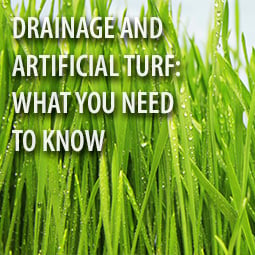
Homeowners here in the Bay Area are all too familiar with drainage problems because so many of us have heavy clay soils. Drainage problems can be especially obvious if you have a natural grass lawn, with frequent puddling and muddy mess. Since rain and watering can’t soak into the soil fast enough, there are often issues with wasteful water runoff or yard erosion. It’s not pretty.
One of the most common questions we get here at Heavenly Greens is, what happens if you switch to artificial turf? How do its drainage capabilities compare to natural grass? We’re always delighted to answer these questions, because artificial turf performs so much better than live grass – when it comes to drainage as well as so many other ways.
Technology trumps Mother Nature (sorry, Mom)
Your natural grass lawn is at the mercy of poorly-draining soil. Artificial turf, on the other hand, has the power to augment and enhance that lousy soil in your yard. It doesn’t just sit there on the surface like a roll of carpet, artificial turf is installed using a multi-layer system that starts well below the surface. (This is one reason professional installation is so important to achieve the performance and longevity you expect from your fake grass.)
Artificial turf is constructed with a porous backing that is specifically designed to maximize drainage and minimize runoff or puddling. It siphons water from the surface, pulling it down into a complex sub-surface leach bed, where it can dissipate naturally or be directed to the nearest drainage system. Our MaxxFlow drainage system is the ultimate when it comes to drainage – watch this video to see how it compares to other systems.
This is no accident. Artificial turf manufacturers have spent decades studying the best ways to construct their products to improve drainage. Then, when the grass is installed, we not only dig deep to ensure excellent drainage, we take great care to smooth the surface so there are no depressions that might collect moisture.
What does all this great drainage mean to you?
- Less mess. Since water doesn’t puddle up on the turf and make mud, there’s nothing for kids and pets to track into the house after a rousing afternoon of play.
- Fewer unwanted bugs and allergens. Standing water and residual dampness that are common with natural grass invite mold, mildew, mosquitoes and other problems. Artificial turf drains and dries quickly, significantly reducing these risks.
- Positive environmental stewardship. Natural grass not only requires enormous quantities of precious water to survive, when you water much of that resource is wasted as runoff, thanks to poor drainage. Artificial turf requires no watering. And if it rains, the drainage system captures that moisture and directs it downward to where it is needed most – into the soil and aquifer. That’s conservation at its finest, and that’s what promotes eco-sustainability.
- Every day is play day. When natural grass remains wet, or even damp below the surface, it can be very slippery, making it easy for anyone playing or walking on the grass to slip and fall. Not so with artificial grass. Even when wet, it is not slippery, so it’s safer and always available for outdoor fun.
Good drainage matters
And with artificial turf, you can actually do something to improve the drainage situation in your yard. Add that to all the other benefits that come with fake grass, and it’s easy to see why savvy homeowners have made the move to artificial turf.

Source link


ASK QUESTIONS
Sponsored Link
Buy Artificial Grass from Manufacturer Directly at Low Price
High-quality artificial grass for garden, playground, football, field hockey, tennis, putting green, and multi-purpose. Located in China and delivers to the world. Minimal quantity 500m². Click to visit the supplier's official website